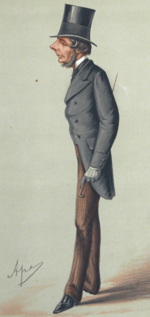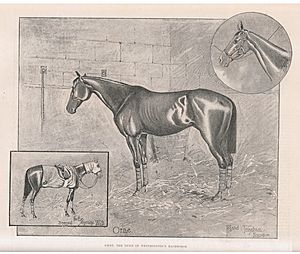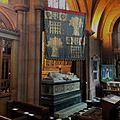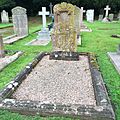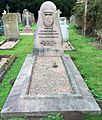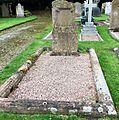Hugh Grosvenor, 1st Duke of Westminster facts for kids
Quick facts for kids
The Duke of Westminster
|
|
|---|---|
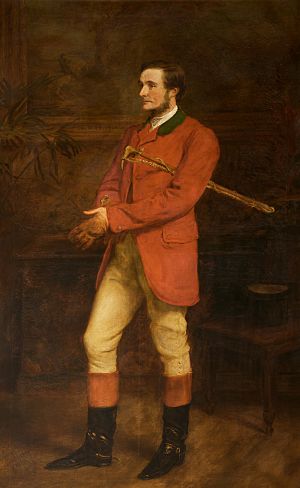 |
|
| Master of the Horse | |
| In office 3 May 1880 – 9 June 1885 |
|
| Monarch | Queen Victoria |
| Prime Minister | William Ewart Gladstone |
| Preceded by | The Earl of Bradford |
| Succeeded by | The Earl of Bradford |
| Personal details | |
| Born | 13 October 1825 |
| Died | 22 December 1899 (aged 74) |
| Nationality | British |
| Political party | Liberal |
| Spouses | (1) Lady Constance Leveson-Gower (d. 1880) (2) Hon. Katherine Cavendish (1857–1941) (m. 1882) |
| Children | Victor Grosvenor, Earl Grosvenor Elizabeth Butler, Marchioness of Ormonde Beatrice Cavendish, Baroness Chesham Lord Arthur Grosvenor Lord Henry Grosvenor Lord Robert Grosvenor Margaret Cambridge, Marchioness of Cambridge Lord Gerald Grosvenor Mary Crichton, Viscountess Crichton Lord Hugh Grosvenor Helen, Lady Henry Seymour Lord Edward Grosvenor |
| Parents | Richard Grosvenor, 2nd Marquess of Westminster Lady Elizabeth Leveson-Gower |
| Alma mater | University of Oxford |
Hugh Lupus Grosvenor, 1st Duke of Westminster (born October 13, 1825 – died December 22, 1899), was a very important English landowner, politician, and horse racing enthusiast. He inherited huge estates, including Eaton Hall in Cheshire and large areas in Mayfair and Belgravia, London. He used much of his wealth to improve these properties.
Even though he was a Member of Parliament (MP) and later a member of the House of Lords, his main interests were not just in politics. He loved managing his estates, racing horses, and enjoying country activities. He built a famous horse breeding stable at Eaton Hall and won the Derby horse race four times!
Contents
Early Life and Family
Hugh Lupus Grosvenor was the second son of Richard Grosvenor, 2nd Marquess of Westminster. His mother was Lady Elizabeth Leveson-Gower. He went to Eton College and then to Balliol College, Oxford. He left Oxford early to become an MP for Chester in 1847. This was a family seat, meaning his family had a long history of representing that area.
In 1851, he traveled to India and Ceylon (now Sri Lanka). The next year, in 1852, he married his cousin, Lady Constance Sutherland-Leveson-Gower. She was 17 years old. Their wedding was a big event, attended by Queen Victoria and Prince Albert. Queen Victoria even became the godmother to their first child, born in 1853. Hugh and Constance had eleven children, and eight of them lived to be adults.
Sadly, Constance passed away in 1880 from a kidney disease. Two years later, in 1882, Hugh married Katherine Cavendish. She was 24, much younger than some of his older children. They had four more children together. The family line for the dukedom eventually continued through the children from this second marriage.
His Public Role
Hugh Grosvenor became an MP for Chester in 1847. He stayed in this role until 1869, when his father died. He then became the 3rd Marquess of Westminster and joined the House of Lords. He didn't speak much in Parliament until 1866. At that time, he disagreed with Prime Minister Gladstone's plans for political reform.
Later, their relationship improved. In 1874, Hugh was made the 1st Duke of Westminster. When Gladstone became Prime Minister again in 1880, he gave Hugh the job of Master of the Horse. This role was perfect for Hugh because of his love for horses, but it wasn't a very political job.
In the 1880s, Hugh and Gladstone disagreed again about Home Rule for Ireland. Hugh even sold a portrait of Gladstone! However, they became friends again when they both spoke out against terrible acts by the Turks against the Armenians. After Gladstone died in 1898, Hugh led a committee to create memorials for him.
Hugh also played a role in the military. He formed a volunteer rifle group in 1860 and led the Cheshire Yeomanry. He supported many charities too. He was president of several London hospitals and groups like the Royal Society for the Prevention of Cruelty to Animals (RSPCA). He also helped the Queen's Nursing Institute, which provided nurses for people who were sick and poor. In 1883, he became the Lord Lieutenant of Cheshire, a representative of the King or Queen in the county.
Developing His Estates
The main country home of the Grosvenor family was Eaton Hall in Cheshire. When Hugh inherited the estate, it was already very valuable. One of the first things he did was order a statue of his ancestor, Hugh Lupus, who was the 1st Earl of Chester.
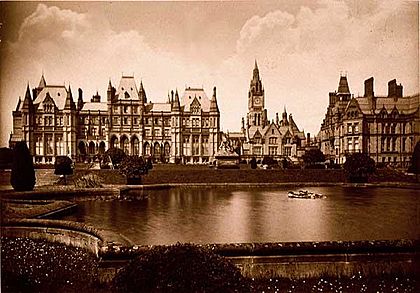
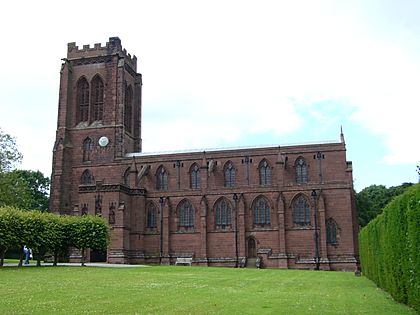
In 1870, Hugh hired a famous architect named Alfred Waterhouse to design a new Eaton Hall. The work took 12 years and cost a lot of money. The new hall was described as a very grand example of Gothic Revival style.
Hugh also paid for many other buildings on his lands. He supported the architect John Douglas, who designed many churches, schools, farms, and cottages for the duke in Chester and on the Eaton estate. He also had St Mary's Church rebuilt in his village of Eccleston.
The Grosvenor family's wealth mostly came from the rent collected from their lands in Mayfair and Belgravia in London. These rents grew a lot during Hugh's time. He oversaw much rebuilding in Mayfair, hiring architects to design new buildings. He liked the Queen Anne style with red brick and terracotta. He was very involved in how his estates looked and were managed.
His Hobbies and Interests
Hugh Grosvenor's biggest passion was horse racing. In 1875, he started a racing stable at Eaton. He had many grooms and horses. He saw this as an important duty for someone of his standing, not just a hobby. He never gambled or placed bets on his horses.
He had great success in racing. In 1880, his horse Bend Or won the Derby. He won the Derby three more times in 1882, 1886, and 1899. It's thought that his horse racing business might have even paid for itself because of his successes and selling horses.
Hugh also enjoyed country activities like deer stalking and shooting in Scotland and on his Cheshire estate. He also added to his family's art collection. He was also a teetotaler, meaning he didn't drink alcohol, and he supported the temperance movement. On his Mayfair estate, he reduced the number of pubs from 47 to just eight.
Final Years and Legacy
In 1899, the last year of his life, Hugh Grosvenor continued to be active. He supported a law to help women working in shops, went deer stalking in Scotland, and attended his granddaughter's wedding. Later that year, he became ill with bronchitis and passed away.
He was cremated, and his ashes were buried at Eccleston Church in Cheshire. There are also memorials to him in Eccleston Church and Chester Cathedral. A stained-glass window in Westminster Abbey also honors him.
His grandson, Hugh, became the 2nd Duke of Westminster after him. When Hugh Lupus Grosvenor died, he was known as the wealthiest man in Britain.
Images for kids
-
Grosvenor Chapel at Eccleston Church: Cenotaph and Garter Banner of the 1st Duke of Westminster
-
South transept at Chester Cathedral: Cenotaph of the 1st Duke of Westminster (detail)


